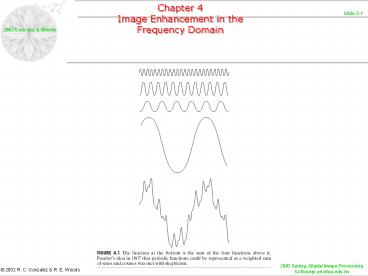2003 Spring, Digital Image Processing PowerPoint PPT Presentation
1 / 46
Title: 2003 Spring, Digital Image Processing
1
(No Transcript)
2
Read Sec. 2 up to p.155
3
(No Transcript)
4
(No Transcript)
5
(No Transcript)
6
(No Transcript)
7
(No Transcript)
8
(No Transcript)
9
(No Transcript)
10
(No Transcript)
11
(No Transcript)
12
(No Transcript)
13
(No Transcript)
14
(No Transcript)
15
(No Transcript)
16
(No Transcript)
17
(No Transcript)
18
(No Transcript)
19
(No Transcript)
20
(No Transcript)
21
(No Transcript)
22
(No Transcript)
23
(No Transcript)
24
(No Transcript)
25
(No Transcript)
26
(No Transcript)
27
(No Transcript)
28
(No Transcript)
29
(No Transcript)
30
EXAMPLE 4.9 High-frequency emphasis filtering.
Transfer function given by Hhfe(u,v)a
bHhp(u,v) (4.4-20) where a ? 0 and b
gt a. Typical values of a are in the range 0.25 to
0.5 and typical values of b are in the range 1.5
to 2.0. With reference to Eq. (4.4-17), we see
that high-frequency emphasis reduces to
high-boost filtering when a (A-1) and b 1.
When b gt I, the high frequencies are emphasized,
thus giving this procedure its name. Figure
4.30(a) shows a chest X-ray with a narrow range
of gray levels. Our main objective is to sharpen
the image. X-rays cannot be focused in the same
manner that lenses are focused, and the resulting
images generally tend to be slightly blurred.
Since the gray levels in this particular image
are biased toward the dark end of the gray scale,
we also take the opportunity here to give an
example of how spatial domain processing can be
used to complement frequency domain filtering.
Figure 4.30(b) shows the result of highpass
filtering using a Butterworth filter (see p.183,
Eq.4.4-3) of order 2 and a value of D0 equal to 5
of the image vertical dimension,
31
Highpass filtering is not overly sensitive
to this parameter, as long as the radius of the
filter is not so small that frequencies near the
origin of the transform are passed. As expected,
the filtered result is rather featureless, but it
shows faintly the principal edges in the image.
The advantage of high-emphasis filtering (with a
0.5 and b 2.0 in this case) is shown in the
image of Fig. 4.30(c). Although the image is
still dark, the gray-level tonality due to the
low frequency components was not lost. As
indicated in Section 3.3, an image characterized
by gray levels in a narrow range of the gray
scale is an ideal candidate for histogram
equalization. As shown in Fig. 4.30(d), this
indeed was an appropriate method to further
enhance the image. Note the clarity of the bone
structure and other details that simply are not
visible in any of the other three images.
The final enhanced image is a little noisy, but
this is typical of X-ray images when their gray
scale is expanded. The result obtained using a
combination of high-frequency emphasis and
histogram equalization is superior to the result
that would be obtained by using either method
alone.
32
(No Transcript)
33
Homomorphic filtering (????) Read p.191 through
193
34
(No Transcript)
35
(No Transcript)
36
(No Transcript)
37
(No Transcript)
38
(No Transcript)
39
(No Transcript)
40
(No Transcript)
41
(No Transcript)
42
(No Transcript)
43
(No Transcript)
44
(No Transcript)
45
(No Transcript)
46
(No Transcript)

